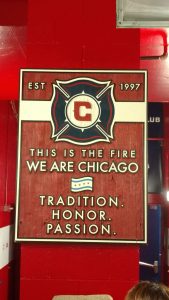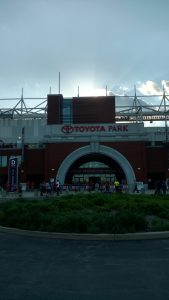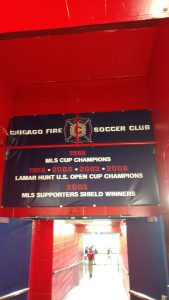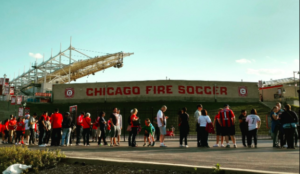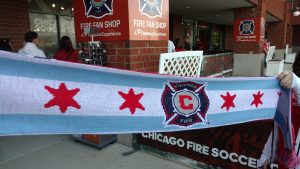On Tuesday, news of the Chicago Fire potentially leaving suburban Bridgeview, moving back to Soldier Field, and even re-branding, dropped.
It was all a bombshell to say the least.
James Vlahakis, a Chicago based attorney who worked as outside counsel for a law firm previously retained by the Fire, first broke the story on Twitter. As the week went on, other outlets followed the lead of Vlahakis, who is currently representing a Fire supporter who has filed suit against the club over an incident at the stadium last season.
On Monday, we had an exclusive conversation with Illinois House Revenue and Finance Committee Chairman Mike Zalewksi, about his spearheading the legislative push to get sports gambling legalized in this state. Zalewski represents the state’s 23rd district, where the Fire’s home, SeatGeek Stadium, resides.
We touched on the stadium and its financial impact on the community, and coincidentally that conversation is now very pertinent to the hot topics surrounding the Chicago Fire.
Before we get to that conversation, here’s what Vlahakis said when he broke the news in a tweet:
Soon to be breaking #cf97 news from a solid source. Nice buyout for Village of Bridgeview, 2/3 of bond debt is being bought out. it is apparently a done deal. pic.twitter.com/rFP4UTVmFs
— J. Vlahakis (@jvlaha) April 2, 2019
To the many who have asked, in addition to my first source (who has never been associated with the Fire in any capacity), long-standing low and high level leakers currently within the Fire FO have also confirmed to others the long in the planning move to Soldier Field. #cf97.
— J. Vlahakis (@jvlaha) April 4, 2019
Depending on what outlet you read/believe, the move back to Soldier Field, where the club played 1998 to 2001 and again from 2003 to 2005, seems to be close to a done deal.
Likewise regarding the breaking of the lease with the village of Bridgeview.
High Press Soccer reports that:
One person with knowledge of the situation said that it’s not quite a done deal, with the actual buyout funds not formally in place yet. Another said the transaction has been approved by MLS.
Two people believed that the rebrand is a new and possibly incomplete element of a general “return to downtown” strategy that’s been in the works for a few years.
Meanwhile ESPN FC’s sources claim:
the deal would involve a significant cash payout towards the debt on the stadium, though no precise numbers were given. Sources also confirmed that the push to get out of the lease has been going on for the better part of a year, with Joe Mansueto, who acquired 49 percent of the club last summer, at the forefront of the efforts.
Meanwhile journalist Shane Nicholson chimed in with this on social media:
I'm gonna tell ya what I know from talking to folks the last couple days about the #cf97 news:
1. Name not decided yet (nor should it be and this is a dumb discussion)
2. Soldier Field is gonna happen
3. Bridgeview gov't is very happy with the deal
4. FourThat's all.
— Shane Nicholson (@ofvoid) April 4, 2019
As of now, the Fire’s only public statement has been this ‘we have no comment, but also we’re neither confirming nor denying it’ style quote, which you’ll see in both the ESPN and High Press Soccer articles:
“We don’t comment on social-media speculation from individuals outside the organization.”
Obviously, the Chicago Fire will make their official announcement only when ready, and it goes without saying that this likely inevitable press release and official club account tweet won’t be going out until all the Is have been dotted and the Ts crossed on the contract.
Regarding the potential rebrand, it seems like that is much further away from happening, if it even does. The idea of changing the name from Chicago Fire to Chicago City FC is apparently only in the test phase, but this logo design idea has already been leaked:
Someone in the know handed this off to us. Take it any way you'd like. #cf97 pic.twitter.com/dNI8itS1I8
— The S??ccer Eagle™ (@TheSoccerEagle) April 4, 2019
Getting back to the finances of the stadium deal, High Press Soccer writes that a buyout of the current deal with Bridgeview is definitely not a minor transaction:
In financial terms, SeatGeek Stadium (which was named Toyota Park from its 2006 debut until this year) was something of a triumph for MLS when it opened, as the Village of Bridgeview publicly financed the entirety of the $95 million venue – and locked the Fire into a seemingly ironclad lease as a consequence. It’s turned out to be a financial disaster for the community, whose population is small enough to fit inside the stadium’s 20,000 capacity.
When it comes to stadiums being financed completely on the public’s dime, well what sports franchise wouldn’t love that kind of sweetheart deal?
And what self-respecting taxpaying American citizen wouldn’t be totally outraged by this all too common act of corporate welfare?
Or as The Simpsons villain Monty Burns told an adoring crowd of his tax-payer funded Springfield Arena: “Welcome to the American dream. A billionaire, using public funds, to construct a private playground for the rich and powerful”. [Crowd cheers].”
That is another discussion for another time, but ESPN has more on the stadium deal being a really bad investment:
The Village of Bridgeview owns the venue, and hoped the venue would spark development in the area. But the stadium has proved to be a massive financial drain on the municipality. Bridgeview sold $134.6 million of bonds in 2005 to finance the project.
But when development in the area failed to materialize, Bridgeview was forced to take on additional debt. A report from Bloomberg stated that as of February of 2018, Bridgeview had about $260 million of general obligation debt, “much of it tied to the stadium.”
That burden saw property taxes for the municipality’s residents double between 2009 and 2013. In 2017, Standard & Poor’s downgraded Bridgeview’s debt rating from investment grade to junk.
You can read more detail about it in this 2015 Crain’s Chicago Business story or this 2012 Chicago Tribune article.
Getting back to Zalewski, he paints a different picture of how the stadium, located in his district, is doing financially.
“I think it should be viewed as a good economic engine for the region,” Zalewski said.
“We get a lot of visitors there every year to see concerts and the Fire, high school football, whatever they’re hosting. I’m a huge supporter of the stadium, and I want to see it succeed.”
When we asked him how it’s done so far he responded:
“I think well, I go to the stadium probably three or four times a year for different events and I’ve always been treated very well there, my kids have been treated well there. It’s a clean, well run facility, so I’m a big fan of it.”
Zalewski is correct- it is a beautiful, well managed facility. More than a decade after its opening, Toyota Park/Seat Geek Stadium is just as state of the art and cutting edge as it was the day it opened.
Unfortunately, the venue fails miserably when it comes to the top three priorities of real estate: “location, location, location.” You just cannot build a facility for the purpose of hosting large crowds and big events in an area that is so egregiously inaccessible by public transportation.
That’s just a basic obvious Urban Planning 101 design flaw that somehow everyone overlooked. You pretty much have to drive, and there’s only one expressway that will get you there from the city and that’s Interstate 55.
Unfortunately, I-55 is one of the worst expressways when it comes to severe traffic congestion, and that really says something, given how Chicago is a city with horrendous traffic congestion issues.
(Interesting aside, the north parking lot of the stadium doesn’t reside in the 23rd, although the rest of the stadium grounds do. That’s the quirks of gerrymandering for you!)
https://twitter.com/PaulMBanks/status/1113454711510839296
Moving back to Soldier Field solves this issue for the Chicago Fire.
While the nearest L stop (Roosevelt) is still a decent walk from the venue, it is very walkable, especially on a nice day, plus you have CTA bus service that takes you right to the gates.
The Fire will likely have to play with the top two tiers of Soldier Field closed, and then hopefully, come as close as they can to filling in the lower bowl. Given what they currently draw these days for home games, it’s a very optimistic, but not unreasonable goal.
Soccer is definitely a hipster sport now in cities all across America. It was not that way in 2006, long before the European game became widely available on American television screens and thus the beautiful game surged in popularity; especially in urban centers. The Fire just simply belong back downtown, and for the most part, popular sentiment seems to agree with that idea.
As for the rebrand, it looks like that would be a case of fixing something that’s not broken. Ever since Vlahakis made that tweet people have weighed in on the idea of ditching the Chicago Fire name to become Chicago City FC and that doesn’t seem to be a very popular idea.
As for Bridgeview and the current facility, well, it’s in real danger of turning into a white elephant, unless they completely revamp the concert schedule. With the Chicago Fire leaving, this can happen now as music acts would take first scheduling priority. Of course, you still have that bigger venue in Tinley Park (the one that changes its name so often we forgot what it’s called four name changes ago) to compete with.
They’re building a new hotel in the parking lot of Seatgeek Stadium, and the Chicago Fire vacating the premises would likely be disastrous for that establishment.
For almost everyone else though, this potential deal looks like a win-win-win.
Paul M. Banks runs The Sports Bank.net, which is partnered with News Now. Banks, a former writer for NBC Chicago.com and Chicago Tribune.com, regularly appears as a guest pundit on WGN CLTV and co-hosts the “Let’s Get Weird, Sports” podcast on SB Nation.
He also contributes sociopolitical essays to Chicago Now. Follow him on Twitter and Instagram. The content of his cat’s Instagram account is unquestionably superior to his.
